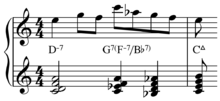- Backdoor progression
-
In jazz and jazz harmony, the chord progression from iv7 to ♭VII7 to I has been nicknamed the backdoor progression[1] or the backdoor ii-V. This name derives from an assumption that the normal progression to the tonic, the ii-V-I turnaround (ii-V7 to I, see also authentic cadence) is, by inference, the front door. It can be considered a minor plagal cadence in traditional theory (see minor scale and plagal cadence).
"Backdoor" also refers to the unexpected modulation created through the substitution of the highly similar IMA9 for iiimi7 (in C: EGBD and CEGBD) at the end of the ii-V turnaround to iii (ii/iii=iv, V/iii=♭VII, iii), thus arriving at 'home' (the tonic) through unexpected means, the 'back' instead of the 'front door'(iiiMI7, EGBD, being entirely contained within IMA9, CEGBD, and the seventh still resolving downward)[2]. If the ii-V-I turnaround is an applied dominant (V/V-V-I), then the backdoor progression may be termed an "applied subdominant" (IV-IV/IV-I).[citation needed]
The backdoor ii-V is considered a "bluesy" cadence and IV-♭VII-I is used repeatedly as a chord substitution, along with tritone substitution, in "Lazy Bird," John Coltrane's arrangement of Tadd Dameron's "Lady Bird."[3]
The backdoor progression can be found in popular jazz standards in such places as measures 7 and 8 of the A section of "Cherokee," measures 9 and 11 of "My Romance" or measures 10 and 28 of "There Will Never Be Another You," as well as Beatles songs like "In My Life" and "If I Fell."
The ♭VII7 chord, a pivot chord borrowed from the parallel minor of the current key, is a dominant seventh. Therefore it can resolve to I; it is commonly preceded by IV going to iv, then ♭VII7, then I. In C major the dominant would be G7: GBDF, sharing two common tones with B♭7: B♭DFA♭. A♭ and F serve as upper leading-tones back to G and E, respectively, rather than B♮ and F serving as the lower and upper leading-tones to C and E.
The use of ♯IIo7 (in C: D♯F♯AC) as a substitute for V7 is similar[1].
See also
Sources
- ^ a b c Coker, Jerry (1997). Elements of the Jazz Language for the Developing Improvisor, p.82. ISBN 157623875X. "Back Door Progression As A Substitute For V7[:] The I chord, in a given progression, is often preceded by IV-7 to ♭VII7, instead of the usual V7 chord.".
- ^ Berg, Shelton (2005). Essentials Of Jazz Theory, p.105. ISBN 0739030892.
- ^ Lyon, Jason (2007). "Coltrane’s Substitution Tune", www.opus28.co.uk/jazzarticles.html.
Andalusian cadence · Backdoor progression · Corelli cadence · Deceptive cadence · English cadence · ii-V-I turnaround · Imperfect cadence · Interrupted cadence · Landini cadence · Perfect cadence · Phrygian cadence · Picardy third · Plagal cadence · Turnaround · ♭VII-V7 cadence
Chord progressions Three-chord ii-V-I turnaround · V-IV-I turnaround · Eight-bar blues · Twelve-bar blues · Sixteen-bar blues · Passamezzo moderno
Four-chord 50s progression · Andalusian cadence · Folia · Montgomery-Ward bridge · Passamezzo antico · Pop-Punk · Romanesca
More Other Aeolian harmony · Backdoor progression · Borrowed progression · Coltrane changes · Constant structure · Double tonic · Harmonic cadence · Irregular resolution · Turnaround
Categories:- Cadences
- Chord progressions
Wikimedia Foundation. 2010.




